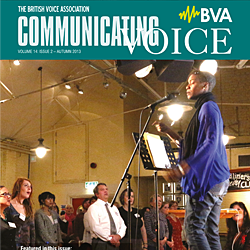About the Association
Archived newsletter articles
Voice Clinic Forum 2006
24 November 2006, Pride Park Stadium, Derby
Report by Sara Harris
The event was efficiently hosted by Sharat Mohan (ENT surgeon) and Kate Young (Speech Therapist) who head up the Derby Voice Clinic Team. The venue provided a wonderful view of Derby Football ground and gave rise to the title of this year's topic 'Fixing the Pitch'.
Ruth Epstein, Sharat Mohan and Kate Young, welcomed the delegates, before Kate and Sharat 'kicked off' the study day with 'The Derby Experience'. They first oriented the audience towards the day's topic by examining the contribution of inappropriate vocal pitch to the field of voice disorders. They illustrated their talk with three case presentations from their Voice Clinic case load who had failed to improve sufficiently with voice therapy alone. The first was a woman with a vocal pitch at the lower end of the male range, which appeared to have been precipitated by hormonal changes after pregnancy. Sharat described the laryngeal framework surgery he carried out to tension the vocal folds bringing her vocal pitch back up towards the lower end of the female range. The second patient was a male whose vocal pitch became inappropriately high after laryngeal trauma. He responded well to a fat injection. The final case was a puberphonic male living in India where voice therapy is less readily available. While laryngeal framework surgery to reduce the tension on the vocal folds would not usually be necessary, in these circumstances, it was carried out to restore an appropriate male pitch range quickly and efficiently.
Gary Wood, (Specialist Speech and Language therapist from the Royal Throat Nose and Ear Hospital, London) took over the vocal pitch theme and presented his experience of working with male to female transsexual patients. He discussed the role of voice therapy with this client group, as well as the different types of laryngeal framework surgery that can be used to raise vocal pitch in patients who respond less well to therapy. Transsexual patients now present much earlier as a result of recent research which has increased our understanding and acceptance of gender dysphoria. Transexual teenagers feel more confident about seeking help early. Their response to therapy and surgery is better and faster than in patients who have only sought help in middle age, when vocal pitch would be lowering anyway, habits are deeply entrenched and the thyroid cartilage may have ossified.
The Charing Cross Hospital is the largest centre for transsexuals in the world with a wealth of research and experience in the field. Cristella Antoni, (Specialist Speech and Language Therapist) gave a masterful overview of the service provided and discussed how voice therapy needs to target more than just the vocal pitch. She described how the whole vocal tract needs to be considered when working with these clients so that the resonating shape is altered to enhance a more feminine voice quality, range and intonation pattern. She discussed some of the pitfalls patients frequently encounter, for example, using falsetto or a very breathy voice quality, and reminded us of the need for the voice to be both appropriate to the patient's physical appearance and to provide an authentic and effective means of communication. The morning speakers then provided a roundtable question/answer discussion.
John Rubin, (ENT surgeon from the Royal Throat Nose and Ear Hospital) completed the morning with an update on the Calnan report into training in laryngology. He explained that in the UK at present laryngology is part of the overall ENT training and the European concept of phoniatrics does not exist. phoniatrics in most European countries involves a specialist training in disorders of communication which takes place following a full ENT training. This extra training can take anything between 18months to 3 years. In Australian, Canadian and US full medical and ENT specialty training is required followed by a further, non compulsory one year course in laryngology. The recommendation is that the UK introduces a new phoniatrics/ advanced laryngology course lasting 1–2 years following the present 4 year training in ENT.
The first afternoon session addressed age related voice change. Guri Sandhu, (ENT Surgeon from Charing Cross Hospital) gave an excellent overview (if rather depressing for those listeners over the age of 21yrs) of the physical changes that take place as part of the aging process, concentrating specifically on how aging affects the vocal folds and vocal tract. He then discussed the present options available for vocally impaired aging patients, including the 'voice lift'. This has become popular in the US and involves an injection of the patient's fat into the vocal folds to increase their bulk and decrease bowing. The improved vocal fold closure usually increases vocal quality, volume and stamina. The topic was extended by Kate Young and Sharat Mohan, who presented cases and talked us through their management decisions and the results of intervention.
The afternoon took on rather a somber mood when John Rubin and Julian McGlashan opened discussion on "Threats to the Voice Clinic". The NHS is in considerable financial difficulty. Many Trusts are in debt and reducing or closing down services to save money. The Government 'Payment by Results' initiative places a tariff of £116 for new ENT patients and £62 for follow up patients. Voice Clinic patients are frequently tertiary referrals from other ENT Consultants with no extra payments available to cover additional procedures or the multidisciplinary nature of voice clinics. In addition the Choose and Book system relies heavily on the GP selecting appropriate services. While specialist services such as voice clinics can be entered into the Choose and Book system, there is no guarantee that the GP will find them or choose them over general ENT services. Other Government initiatives such as introduction of Independent Treatment Centres, and decentralisation of services back into the Community further reduce the chances of maintaining a referral pathway to the voice clinic. New regulations regarding sterilization of equipment will have huge impacts on Voice Clinic costs. More scopes will be required, increasing the capital outlay, and if the sterilization process is put out to tender it may no longer take place on site, requiring a possible 24 hours turn around time.
The day finished with a number of short audit presentations. Philippa Ratcliffe, representing the Royal Throat Nose and Ear Speech Therapy Team, discussed Voice Clinic booking practices and presented a point system referral prioritization scheme. Suzanne Slade presented the Nottingham Voice Clinic audit of SLT lead Endoscopy training practices in the UK. Kate Young and Sharat Mohan presented their audit into the outcomes of different thyroplasty techniques and Anita Sonsale spoke about her audit comparing objective and subjective voice analysis. Emma Walker and Pat Henshaw were scheduled to present the York audit into patient and referred involvement in voice clinic referral, but were sadly unable to attend.
The day was efficiently administrated and supported by Kristine Carroll Porczynski and Jackie Ellis of the BVA and our thanks goes out to them, Kate Young, Sharat Mohan and all the speakers who helped to make this an extremely valuable and informative study day.
A Personal Perspective
By Valerie Morton, Speech & Language Therapist, Belfast City Hospital Trust
Pride Park is known to football fans as the home ground of football championship team Derby County. But on Friday November 24, the stadium played host to a squad of 80 members of the BVA who had arrived there from all parts of the UK.
The reason for gathering was the 3rd Annual Voice Clinic Forum Day and what a valuable event it turned out to be. So much so, that my speech and language therapy colleague, Catherine McMullen and I did not complain about having to be up with the lark in time to catch the 7.30 am flight from Belfast International Airport!
Appropriately, given the venue, the theme for this year's forum was "fixing the pitch", age related voice lift and voice clinic audits. In addition there were updates on specialist training in laryngology and on threats to voice clinics – all very relevant topics to those of us in practice.
The whole event proved to be absorbing. For me, as someone who has been a voice therapist for 25 years and a member of a voice clinic team since 1990, there were many points for interest. The main themes that I came away with were the value of multidisciplinary working, the importance of evaluating our work, the need to make necessary changes and the requirement to be aware of reforms within the NHS in order to develop a proactive approach. Speech and language therapy intervention and surgical management of pitch problems with specific patients including transsexual clients were presented with good sound reference to individual case studies. Conservative and surgical options were also considered for the aging voice. Particularly striking was a video presentation by Sharat Mohan showing how abdominal fat can be used in vocal cord augmentation. All audits were pertinent and Philippa Ratcliffe showed very clearly how she approached two frequently reported problems – prioritisation of patients and waiting lists.
To sum up, there were lots of thought provoking presentations, stimulating discussion and it was a great opportunity to renew the acquaintance of regular BVA delegates and meet new members. Sincere thanks to the organisers for all their hard work. Roll on the 4th Voice Forum.
More archived content online
Disclaimer
Neither the British Voice Association nor the Editor can be held responsible for errors or any consequences arising from the use of information contained in its newsletters (or extracts from its newsletters published online); the views and opinions expressed do not necessarily reflect those of the British Voice Association (BVA) or the Editor, neither does the publication of advertisements constitute any endorsement by the BVA or Editor of any products or services featured.

 Join us Now!
Join us Now! our newsletter
our newsletter free voice care leaflets & information – download here
free voice care leaflets & information – download here Help our work by donating while you shop
Help our work by donating while you shop